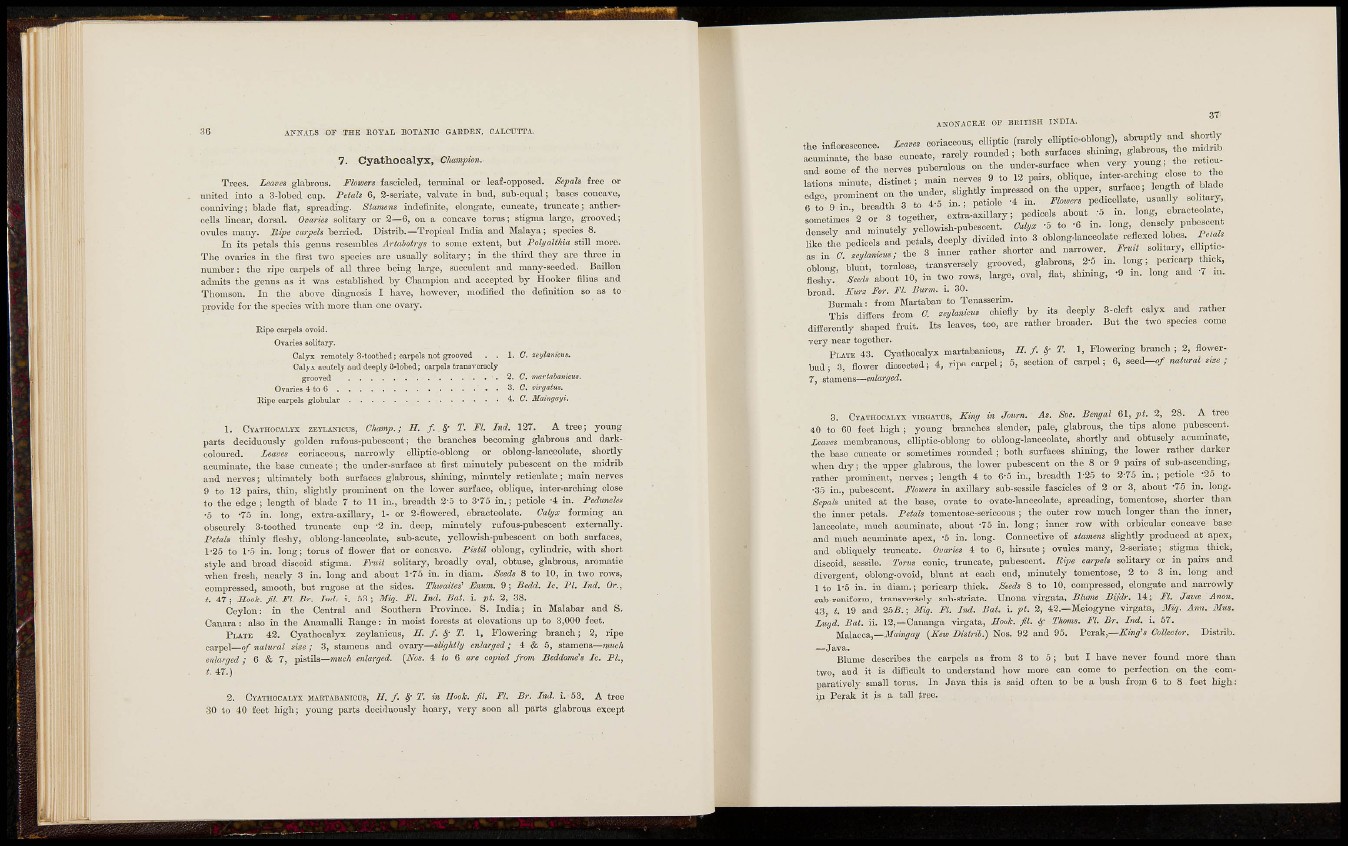
36 AI^NALS OF THE EOYAL BOTANIC GAKDEîT, CALCUTTA.
7. Cyathocalyx,
Trees. Leaves glabrous, Flowers fasciclcd, teraiinal or leaf-opposed. Sepals free or
united into a 3-lobcd cup. Petals 6, 2-seriate, valvate in bud, sub-equal ; bases concave,
couniviug; blade flat, spreading. Stamens indefinite, elongate, cuneate, tmncate; anthercells
linear, dorsal. Ovaries solitary or 2—6, on a concave torus; stigma large, gi-ooved;
o-\-ules many. Bipe carpels berried. Distrib.—Tropical India and Malaya; species 8.
In its petals this genus resembles Artabotrijs to some extent, but Polyalthia still more.
The ovaries in the first two species are usually solitary; in the thii-d they are thi-ec in
number: the ripe carpels of all thi-ee being large, succulent and many-seeded. Bâillon
admits the genus as it was established by Champion and accepted by Hooker filius and
Thomson. In the above diagnosis I have, however, modified the definition so as to
pi-ovide for the species with more than one ovaiy.
Eipe carpels ovoid.
Ovaries solitary.
Calyx remotely 3-tootbe(J ; carpels not grooved . . I. C. teylanicus.
Calyx acutely and deeply 3-lobed; carpels transversely
grooved 2. C. martabanicus.
Ovaries 4 to 6 Z. 0. virgatus.
Ripe carpels globular 4. C. Maingayi.
1. CYATHOCALYX ZEYLAKICUS, Champ.; E. f . ^ T. Fl. Ind. 127. A tree; young
parts deciduously golden rufous-pubescent; the branches becoming glabrous and darkcoloured.
Leaves coriaceous, narrowly elliptic-oblong or oblong-lanceolate, shortly
acuminate, the base cuneate; the under-surface at first minutely pubescent on the midrib
and nerves; ultimately both surfaces glabrous, sinning, minutely reticulate; main nerves
9 to 12 pairs, thin, slightly prominent on the lower surface, oblique, inter-arching close
to the edge ; length of blade 7 to 11 in., breadth 2-5 to 3-75 in.; petiole -4 in. Peduncles
•5 to -75 in. long, extra-axillary, 1- or 2-fiowered, ebracteolate. Calyx forming an
obscurely 3-toothed trancate cup -2 in. deep, minutely rufous-pubescent extoraally.
Petals thinly fleshy, oblong-lanceolato, sub-acute, yellowish-pubescent on both surfaces,
1-25 to 1-5 in. long; torus of flower flat or concave. Pistil oblong, cylindric, with short
style and broad discoid stigma. Fruit solitary, broadly oval, obtuse, glabrous, aromatic
when fresh, nearly 3 in. long and about 1-75 in. in diam. Seeds 8 to 10, in two rows,
compressed, smooth, but rugose at the sides. Tlmaites' Fiium. 9; Bedd. Ic. PL Ind. Or.,
t. 47; Mook. fil. Fl. Br. Ind. Í. 53 ; Miq. FL Ind. Bat. i. pt. 2, 38.
Ceylon: in the Central and Southern Province. S. India; in Malabar and S.
Cañara: also in the Anamalli Range: in moist forests at elevations up to 3,000 feet.
PLATE 42. Cyathocalyx zeylanicus, E. f . ^ T. 1, Flowering branch; 2, ripe
carpel—0/naíwm^ size; 3, stamens and ov&vj^sli^htly enlarged; 4 & 5, stamens—wac/i
enlarged; 6 & 7, pistils—rawcA enlarged. {Nos. 4 ío 6 are copied from Beddamés Ic. PL,
t 47.)
2. CYATUOCALYX MAKTABANICUS, H. / . T. in Uook. fiL FL Br. Ind. i. 53. A tree
30 to 40 feet high; young parts dcciduously hoary, very soon all parts glabrous except
A^^ONACE^ OF BRITISH INDIA,
the inflorescence. coriacoous, elliptic (rarely ellipticoblong), abruptly and s t ^ i ty
r j and nan.„wo. ^ U C^^ic-
' b i ng b unt, tordose, t a « B e l y grooved, glataon., 2-5 m. long; p.ncarp «nek.
flX « -bout 10, in two rows, largo, oval, flat, sbining, -9 m. long and -7 m.
broad. Kurs For. Fl. Burm. i. 30.
Bui-mali: from Martoban to TonasBOrim. , , , ,
This difiers from C. i^slanicm chiefly by its deeply 3-deft calyx and rather
difierently shaped £mit. Its leaves, too, are rather broader. Bnt the two species come
•very near together.
PLATE 43 Cyathocalyx martabanicus, B. f . ^ T. 1, Flowering branch ; 2, flowerbnd;
3, flower dissected-, 4, ripe car-pel; 5, section of carpel; 6, s e e d - « / nalnml ;
7, stamem—euhracd.
3. CYATHOCALYX VIEGATUS, Kinff in Jmirn. As. Soc. Bengal 61, pt. 2, 28. A tree
40 to 60 feet high ; yonng branches slender, pale, glabrons, the tips alone pubescent.
Leaves membranous, elliptic-oblong to oblong-Ianeeolate, shortly and obtusely acuminate,
the base cuneate or sometimes rounded ; both sm-faces shining, the lower rather darker
when dry; the upper glabrous, the lower pubescent on the 8 or 9 pairs of sub-ascending,
rather prominent, nerves ; length 4 to 6-5 in., breadth 1-25 to 2-7S in. ; petiole -26 to
•35 in., pubescent. Flowers in axillary sub-sessile fascicles of 2 or 3, about -75 in. long.
Sepals united at the base, ovate to ovate-lanceolate, spreading, tomentose, shorter than
the inner petals. Petals tementose-sericeous ; the outer row much longer than the inner,
lanceolate, much acuminate, about -75 in. long; inner row with orbicular concave base
and much acuminate apex, -5 in. long. Connective of slamem slightly produced at apex,
and obliquely truncate. Ooaries 4 to 6, hirsute; ovules many, 2-seriate; stigma thick,
discoid, sessile. I'orm conic, truncate, pubescent. Ripe carpels solitaiy or in pairs and
divergent, oblong-ovoid, blunt at each end, minutely tomentose, 2 to 3 in. long and
1 to 1-5 in. in diam.; pericarp thick, Seeds 8 to 10, compressed, elongate and naiTowly
sub-reniform, transversely sub-striate. TJnona virgata, Blume Bijir. 14; Fl. Java Arum.
43, t. 19 and 35S.; Miq. FL Ind. Bat. i. pt. 2, 42.—Meiogyne vii-gata, i¥!}. Ann. Mus.
Ztigd. Bat. ii. 12,—Cananga virgata. Boot. fil. ^ Thorns. Fl. Br. Ind. i. 67.
M a l a c c a , — { K e w Disirii.) Nos. 92 and 95, Perak,—Xinff^s Collector. Di.sti-ib.
—Java,
Blume describes the carpels as from 3 to 5; but I have never found more than
two, and it is difficult to understand how more can come to perfection on the comparatively
small torus. In Java this is said often to be a bush from G to 8 feet higji;
in Perak it is a tall tree.